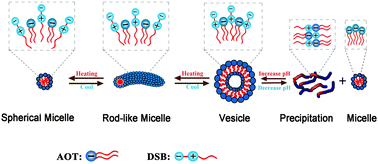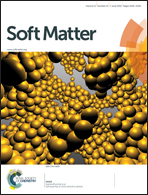Dual stimuli-responsive self-assembly transition in zwitterionic/anionic surfactant systems†
Abstract
Temperature and pH responsiveness is important for biological applications in protein reconstitution, gene delivery and controlled drug release. The temperature and pH dual responsive self-assembly transition, vesicle-to-micelle transitions (VMTs) and micelle-to-vesicle transitions (MVTs), in dodecyl sulfonatebetaine (DSB)/sodium bis(2-ethylhexyl) sulfosuccinate (AOT) aqueous solution are investigated. Various experimental techniques including cryogenic transmission electronic microscopy, UV-vis spectroscopy, fluorescence spectroscopy, conductivity, and zeta potential were employed to verify the transformation process. Encapsulation of calcein was further applied in this study. The results showed that the self-assembly transition in DSB/AOT aqueous solution is reversible and can be controlled by temperature and pH. It is anticipated that utilizing simple stimuli methods to realize unique self-assembly behaviour in dilute aqueous solution may offer new possibilities in cancer diagnosis and therapy.


 Please wait while we load your content...
Please wait while we load your content...